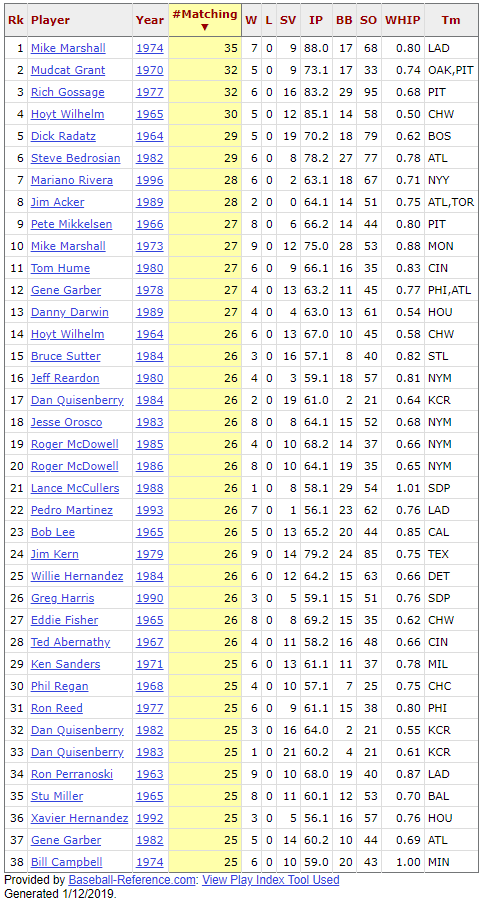Every year since 2008, 75% of relief appearances have been one inning or less. With that type of specialization, getting a clean appearance, or one without any charged runs, is the objective just about every time the manager goes to the bullpen. More on relief pitchers with the cleanest seasons is after the jump.
Baseball-Reference.com shows 2884 pitcher seasons since 1908 with at least 60 relief appearances, the earliest in 1939. The 1964 season was the first with 10 or more pitchers reaching this threshold, with that number climbing to 25 in 1980, 50 in 1991, 75 in 1998 and 100 in 2007. The chart looks like this:

These seasons of 60 relief appearances are the focus of this analysis of clean relief seasons, being those with no charged runs in 80% of appearances. Bear in mind that not being charged with a run does not always mean an effective relief appearance, as a subsequent reliever may clean up a mess left by an earlier pitcher. Nor does an appearance with a charged run necessarily mean a pitcher was ineffective, especially if the charged run is unearned, or a subsequent pitcher couldn’t get the final out. But, over the course of 60 appearances, the number of clean outings is probably a good barometer of effective relief pitching.
Let’s start with the super clean seasons, those with 90% clean appearances. Here’s the list, with stats shown for only the clean appearances.

Some of the more memorable relief seasons are represented here, including those by Zach Britton, Dennis Eckersley and Eric Gagne. And, obviously, clean seasons averaging close to an inning per appearance are more impressive and more valuable than the others with half as many innings. So, what are the most innings in the clean appearances of a clean season (remember that a clean season is 80% clean appearances in a season of 60 relief outings). Here’s that list.

Some old-time seasons here, back when going more than an inning was the rule rather than the exception.
So far, we’ve been looking at individual seasons. But, what about consistent performance over many seasons. Here’s that list.

Many familiar names, but also some surprises. What about notables that aren’t here? Here are some of those.

Impressive that John Smoltz shows up with two clean seasons out of only three with 60 relief appearances.

Tougher on the old time pitchers to get more than a season or two with so many outings of longer than an inning. Or no clean seasons at all, as was the fate for this list of notable pitchers.

Finally, let’s look at career results, counting all seasons with any relief appearances. Here are the players with 80% clean relief appearances, with a minimum of 300 clean outings.

Looking instead of most clean appearances in a career, the list looks like this.


